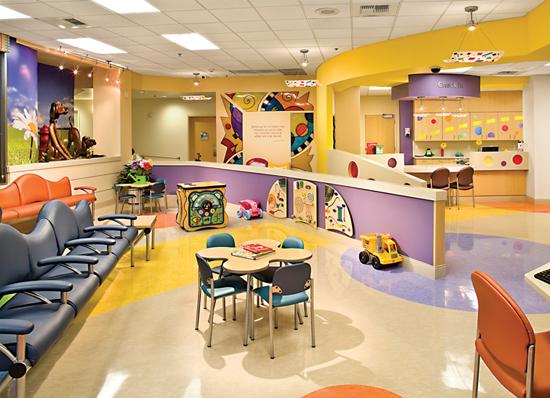Healthcare Design Conference Review - Dec 2012
By Ruth Simon McRae
The Healthcare Design Conference celebrated its tenth anniversary in Phoenix, Arizona, November 3 to 6. Over 4,000 visitors attended the conference, representing the full spectrum of the healthcare industry—architecture, interior design, facility management, hospital administration, construction, product design and manufacturing. Founded by Healthcare Design magazine partnering with The Center for Health Design, the conference is produced in conjunction with AIA, IIDA and the Healthcare Council of IFMA.
In addition to hearing keynote speeches by industry experts and expanding their knowledge during the jam-packed schedule of educational sessions and roundtable discussions, participants could earn up to 24 CEU credits from their respective professional organizations.
The exhibit hall seemed fully occupied by nearly 270 companies, including 30 from the flooring industry. Nearly all carpet companies were represented, with the exception of the few that do not currently offer hard surface products. Flooring company representatives were busy talking to and meeting with customers, and seemed pleased with the conference overall. Fred Roche, president of Parterre Flooring Systems, commented, “The group that puts on this show should be congratulated for putting together a viable tool and creating an inviting venue for manufacturers to get together with committed clients.”
The mood at Healthcare Design was upbeat. Dan Noble, president of AIA’s American Institute for Health, described some of the factors contributing to the positive mood, including the rise of the Architectural Index to a two-year high, the addition of 20,000 new construction jobs in October, and rising project inquiries.
Much of the conference content concerned change; topics included the future of healthcare, evolving delivery systems, and changing demographics, to name a few. The impact of the Affordable Care Act with its projected addition of 32 million healthcare customers and changes in Medicare reimbursement were widely discussed. Many presenters concurred with keynote speaker Derek Parker, who said: “Our buildings are too expensive. We can’t afford them, can’t afford to build and to operate them.”
He went on to say that “value engineering is an oxymoron.” A supplier who understands this situation will be open to material suppliers that offer real value, functionality, risk-reduction, and ease of maintenance in their product solutions.
Another key development is that primary care is moving closer to patients, beyond the urgent care center model that has been rapidly expanding. Futurist Joe Flowers, and others, are predicting that medical outlets will be developed in easily accessible retail outlets and in home-based environments. This trend will have an impact in increased demand for flooring, with a wider range of flooring products considered appropriate for healthcare.
Several of the educational sessions concerned global healthcare issues from a variety of perspectives, including facility case studies and discussions about the influence of various cultures on design.
The Healthcare Design Conference show is one of the key opportunities for manufacturers to introduce products for this market, and there were some great ones. Several of the products shown were first displayed at NeoCon, and, as is often the case, became market-ready in the fall. In some cases, mills tend to feature only corporate-focused products at NeoCon. Healthcare Design offers these companies a separate venue to showcase new products that have been designed specifically for the healthcare market.
Product design recognition came in the form of the annual Nightingale Awards, which were sponsored by The Center for Health Design.
Armstrong received the Silver award in the Flooring: Hard Surface category, for Striations BioBased tile. A softly striated visual, this new product was displayed with compelling room scene images and an imaginative floor layout.
Nora was awarded the Gold award in the same category for Sentica, a rubber sheet product with a tone-on-tone, clean, sophisticated visual. Sentica adds range to Nora’s portfolio, expanding beyond the distinct chip look seen in products such as Environcare.
The Silver award was won by Patcraft’s Cultural Layers collection. Also featured was Stratified, a rectangular format LVT tile with a horizontal, limestone visual.
Tandus won the Gold award in the Flooring: Carpet category for its Novo collection, a group of five coordinated broadloom designs in a range of softened geometric patterns. Novo was developed specifically for the senior living market.
Healthcare Design is the premier conference of its type for the healthcare market, as it has been for the last ten years. The 2012 conference in Phoenix was a highly successful, well-attended show. Participants report that Healthcare Design Conference is an excellent venue to gain insight about trends and best practices in healthcare, showcase new products, and get close to key customers. The conference should only get better as time goes on, as the healthcare markets continue to grow and evolve.
|
KEY PRODUCTS AT HEALTHCARE DESIGN CONFERENCE 2012 |
|
Armstrong presented Striations BioBased tile, with compelling room scene images and an imaginative floor layout. |
Copyright 2012 Floor Focus
Related Topics:Shaw Floors, Armstrong Flooring, The American Institute of Architects, Parterre Flooring Systems, Mannington Mills, Mohawk Industries, Interface, Shaw Industries Group, Inc.
